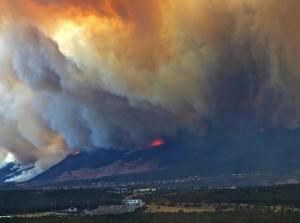 Within the last few weeks, huge forest fires have broken out all across Colorado, including the massive High Park fire, the menacingly city-close Waldo Canyon fire outside Colorado Springs, and as I’m writing this the Flagstaff fire near Boulder is quickly becoming fast-moving and dangerous. The perfect mixture of high temperatures, low humidity, and snow packs in Colorado at only 2 percent of normal have left the state vulnerable to wildfires, and it appears nature is collecting on the opportunity. A helpful tool from ESRI makes it easy to see the great number of wildfires burning not only in Colorado, but across the United States.
Within the last few weeks, huge forest fires have broken out all across Colorado, including the massive High Park fire, the menacingly city-close Waldo Canyon fire outside Colorado Springs, and as I’m writing this the Flagstaff fire near Boulder is quickly becoming fast-moving and dangerous. The perfect mixture of high temperatures, low humidity, and snow packs in Colorado at only 2 percent of normal have left the state vulnerable to wildfires, and it appears nature is collecting on the opportunity. A helpful tool from ESRI makes it easy to see the great number of wildfires burning not only in Colorado, but across the United States.
The 2011-2012 Colorado winter season saw very low snow accumulation and unusually warm temperatures. Skiers and snowboarders experienced a lackluster season, which left ski industries clamoring to keep their resorts open. Higher temperature as a result of climate change means that in the near future, Colorado may no longer be a ski and snowboarding destination. Robust winters may become a thing of the past, leaving Colorado mountains generally dry during the winter months. While the loss of snow accumulation during the winter months may be an economic disaster for the ski industry, it also means dangerous droughts and long, dry summers threatening wildfire.
This summer, like ten years ago, is shaping up to be a difficult year for Colorado. If climate change continues to cause warm winters and hot, dry summers, wildfires like these are only going to become more common. But are people making the connection that this is what Colorado can expect if climate change continues to go unchecked? Just last week, the conclusion of the 2012 Rio Earth Summit left many participants in the summit disappointed and some downright outraged by the lack of real commitments made by participating governments. It seems to many people that world leaders are still shirking their duties to address climate change. This summer will serve as yet another wake-up call for what climate change holds in store for us.
Climate is, of course, different than weather. Weather is what is happening today, tomorrow, and next week. Climate, on the other hand, is what happens over a long period of time, stretching many years. For all I know, this coming winter could have huge snowfalls, and next summer could be lush with rain. That doesn’t mean that within the next fifty, one-hundred, or two-hundred years, Colorado’s weather could regularly see summer temperatures reaching above one-hundred degrees, almost no rain, and tiny deposits of winter snowpack. And make no mistake, we are heading in that direction. If that is what typical Colorado weather becomes, everybody better get used to packing up and fleeing from wildfires, especially as more and more development moves into the wilderness.
When it comes to climate change, indicators are usually small events, relatively unnoticed by the general population. These wildfire should serve as a big slap in the face that climate change is real, and it is happening right now. So while everyone is talking about how terrible these fires are, make sure you remember that we are causing them. This, ladies and gentlemen, is what you can expect, year-after-year, from climate change.
Image URL: http://media.zenfs.com/en/blogs/sptusncaafexperts/AwW_uP_CIAAW1d_.jpg_large.jpg

